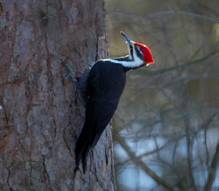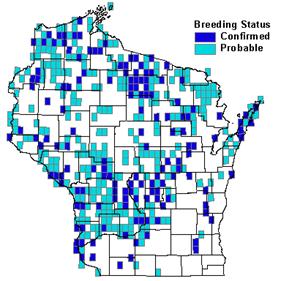Photo by Dennis Malueg


Status/Protection
- Global Rank: G5 Key to global and state ranks
- State Rank: S3B, SZN
- State Status: NA
- WBCI Priority: None
Population Information
The Federal BBS information can be obtained at http://www.mbr-pwrc.usgs.gov/bbs/bbs.html by clicking on Trend Estimates and selecting the species in question. All estimates are for time period (1966-2005).
- Federal Breeding Bird Survey: significant increase
- Federal Breeding Bird Survey (WI): significant increase
- Federal Breeding Bird Survey (BCR 23): significant increase
- Federal Breeding Bird Survey (BCR 12): significant increase
- WSO Checklist Project: significant increase (1983-2007)
Life History
- Breeding Habitat: Bottomland Hardwood, Aspen, Northern Hardwood, most older forest types.
- Nest: cavity, in living or dead tree (Ehrlich et al. 1988, Bull and Jackson 1995).
- Nesting Dates: late April – late May (WSO 1995).
- Foraging: bark gleaner (Ehrlich et al. 1988).
- Migrant Status: Permanent Resident.
- Habitat use during Migration: no real migration in WI; permanent resident (Robbins 1991).
- Arrival Dates: permanent resident, no arrival dates (Robbins 1991).
- Departure Dates: permanent resident, no arrival dates (Robbins 1991).
- Winter Range: permanent resident, same as breeding range (eastern North America, southern Canada, Pacific Northwest [Bull and Jackson 1995]).
- Winter Habitat: same as breeding habitat; (see Habitat Selection, below).
Habitat Selection
The Pileated Woodpecker uses a variety of deciduous and coniferous forest types across its geographic range, preferring forests with large trees, including elms, hickories, oaks, maples, hackberry, pines [and other conifer species in the West (Bull and Jackson 1995)]. Robbins (1991) reported all nest cavity records from Wisconsin were found in deciduous trees. Because of its size, Pileated Woodpecker cavities are large relative to other cavity dwellers, with inside diameters varying from 15-21 cm (6-8 inches [Bull and Jackson 1995]). For this reason, only woodlands and forests with at least some large trees are suitable for occupancy. Studies in Missouri, Virginia, Kentucky, Oregon and Washington report nest tree diameter at breast height (DBH) ranging from 30 to 100 cm (12-40 inches). Pileated Woodpeckers prefer forests with adequate roosting trees, which are often hollow trees with multiple entrance holes. The demise of the American elm due to Dutch elm disease created increased nesting and foraging opportunities for Pileated Woodpeckers in WI (Nichols 1994).
This species was nearly extirpated from large areas of Wisconsin by ~1900, but with the regrowth of forests and protection from shooting, it began a noticeable recovery by ~1950, with additional recovery and range expansion in the state continuing to present day (Robbins 1991). Wisconsin Breeding Bird Atlas data confirm this statement with recent nesting records from many areas in southeastern Wisconsin, where the Pileated Woodpecker had been extirpated. Specific reports include the Kettle Moraine State Forest-Southern Unit, Cedarburg Bog and Cedarburg Beech Woods State Natural Areas (SNA), Kewaskum Maple-Oak Woods SNA, and other locations.
In Wisconsin, the Pileated Woodpecker is generally found in northern pine (Hoffman and Mossman 1990), boreal (Mossman et al. 1990), southern upland (Mossman and Hoffman 1989), northern swamps and bogs (Hoffman and Mossman 1993), and northern mesic (Hoffman 1989) forest types.
Habitat Availability
Mature stands of most forest types should provide quality habitat for the Pileated Woodpecker. Conversely, intensely managed young forests are less likely to provide the mature trees needed for cavity excavation and occupancy. In addition, Bull and Jackson (1995) suggest that conversion of old-growth forests to managed stands may limit local Pileated Woodpecker populations. At present this does not appear to be a problem in Wisconsin, as numbers continue to increase statewide.
Population Concerns
No population concerns currently exist for the Pileated Woodpecker in Wisconsin. All population surveys and other evidence suggest the species is increasing in abundance and expanding its breeding range.
Recommended Management
Howe et al. (1992) list the Pileated Woodpecker as a “special needs” species, along with a group of other cavity-nesting species. They state that current “forest management guidelines…call for retention of a prescribed density of snags or cavity trees” (Howe et al. 1992), but add that continued monitoring of cavity-nesting species is needed. Protection of large-diameter trees within managed forests is a beneficial management strategy for this species. Removal of large live or dead trees during harvest, fallen trees, and opening of the canopy can eliminate potential nest and roost sites, and foraging areas of the Pileated Woodpecker (Bull and Jackson 1995).
Research Needs
Additional work is needed to examine the Pileated Woodpecker’s reproductive success and dispersal of young. This species sometimes chooses utility poles or wooden siding on buildings for cavity excavation, either for nesting cavities or excavation in search of prey. Studies are needed to learn why PIWO and other woodpecker species choose buildings, and determine non-lethal methods to persuade woodpeckers to avoid such behavior (Bull and Jackson 1995). Recent studies in Canada have reported that Pileated Woodpeckers and Northern Flickers are providing most of the cavity structures used by >22 cavity nesting species (Martin et al. 2004). Similar research on the importance of cavity excavators in Wisconsin is needed.
Information Sources
- Wisconsin Breeding Bird Atlas http://www.uwgb.edu/birds/wbba/
- Nicolet NF bird survey map http://www.uwgb.edu/birds/nnf/species/PIWO.htm
- Chequamegon NF bird survey map http://oden.nrri.umn.edu/mnbirds/accounts/PIWOm2.htm
- NRRI species account http://oden.nrri.umn.edu/mnbirds/accounts/PIWOa2.htm
References
- Bull, E.L., and J.E. Jackson. 1995. Pileated Woodpecker (Dryocopus pileatus). In The Birds of North America, No. 148 (A. Poole and F. Gill, eds.). The Academy of Natural Sciences, Philadelphia, PA, and The American Ornithologists’ Union, Washington, D.C.
- Ehrlich, P.R., D.S. Dobkin, and D. Wheye. 1988.The birders handbook: a field guide to the natural history of North American birds. Simon & Schuster, Inc. New York.
- Hoffman. R.M. 1989. Birds of Wisconsin northern mesic forests. Pass. Pigeon 51(1): 97-110.
- Hoffman, R.M., and M.J. Mossman, 1990. Birds of northern Wisconsin pine forests. Pass. Pigeon 52(4): 339-356.
- Hoffman, R.M., and M.J. Mossman. 1993. Birds of Wisconsin’s northern swamps and bogs. Pass. Pigeon 55(2): 113-137.
- Howe, R.W., M.J. Mossman, and S.A. Temple. 1992. Effects of natural forest management on birds in northern Wisconsin. Pass. Pigeon 54 (4) 297-306.
- Martin, K., K.E.H. Aitken, and K.L. Wiebe. 2004. Nest-sites and nest webs for cavity-nesting communities in interior British Columbia: nest characteristics and niche partitioning. Condor 106:5-19.
- Mossman, M.J., E. Epstein, and R.M. Hoffman. 1990. Birds of Wisconsin boreal forests. Pass. Pigeon 52(2): 153-168.
- Mossman. M.J., and E. Epstein. 1991. Birds of Wisconsin pine and oak barrens. Pass. Pigeon 53(2): 137-163.
- Mossman, M.J., and R.M. Hoffman. 1989. Birds of southern Wisconsin upland forests. Pass. Pigeon 51(4): 343-358.
- Nichols, T.H. 1994. Pileated Woodpecker use of elm trees killed by Dutch elm disease in northern Wisconsin. Pass. Pigeon 56: 21-28.
- Price, J., S. Droege, and A. Price. 1995. The summer atlas of North American birds. Academic Press, New York.
- Robbins, S. D. 1991. Wisconsin birdlife: population & distribution, past & present. Univ. of Wisconsin Press, Madison, WI.
- Robbins. S.D., D.W. Sample, P.W. Rasmussen, and M. J. Mossman. 1996. The breeding bird survey in Wisconsin: 1966-1991. Pass. Pigeon 58(2): 81-180.
- Temple, S.A., J.R. Cary, and R.Rolley. 1997. Wisconsin birds: a seasonal and geographical guide. Second edition. Univ. of Wisconsin Press, Madison, WI.
- Wisconsin Society for Ornithology. 1995. Wisconsin breeding bird atlas; atlasing handbook 1995-1999. Wisconsin Society for Ornithology, Inc., Hartland, WI.
Contact Info
- Compiler: William P. Mueller, 414-643-7279, iltlawas@earthlink.net
- Editor: Jim Woodford, 715-365-8856, james.woodford@dnr.state.wi.us
